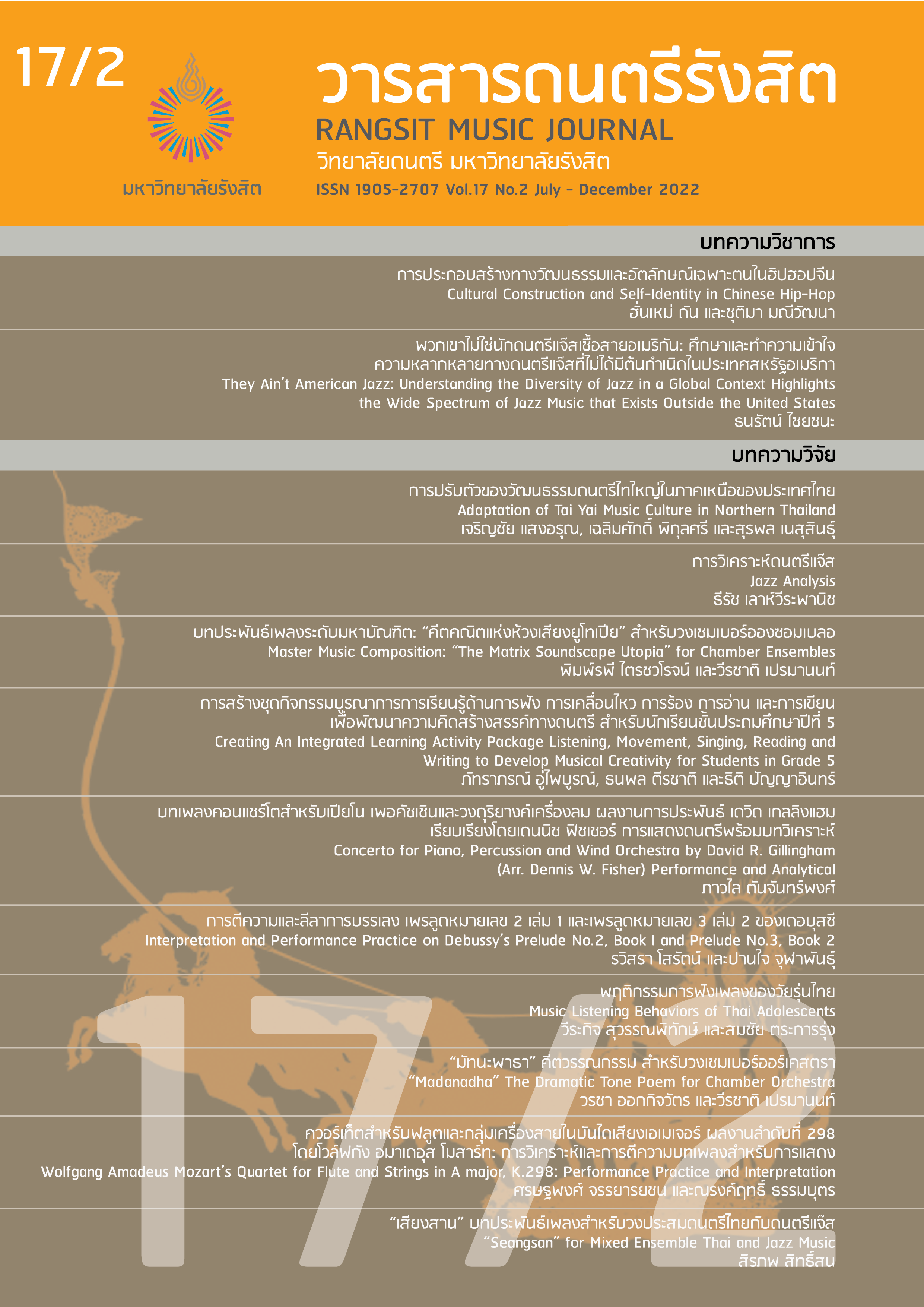They Ain’t American Jazz: Understanding the Diversity of Jazz in a Global Context Highlights the Wide Spectrum of Jazz Music that Exists Outside the United States
Keywords:
Global Jazz, Gypsy Jazz, Japanese Jazz, Scandinavian Jazz, Australian JazzAbstract
The influence of jazz can be experienced all over the globe. Yet it appears that Thai jazz performers place a high value on the influence of jazz that originates predominantly from the United States. Many diverse types of jazz music have been produced, improved, enhanced, and reinterpreted in many different countries to coordinate the context of local cultural practice, resulting in a musical style that is distinct from American jazz. Bruce Johnson (2002) and Stuart Nicholson (2014) defined such a concept of diversity of jazz as “global jazz,” which highlights the wide range of jazz music that is distinct from the jazz music that originated in the United States. Therefore, this paper examines the influences of jazz music that appear outside of the United States, mainly gypsy jazz, and Scandinavian, Japanese, and Australian jazz, based on artistic perspectives, historical contexts, and socio-cultural aspects to promote the diversity of jazz to Thai readers.
References
Atkins, E. Taylor. Blue Nippon. Durham, NC: Duke University Press, 2001.
Cotro, Vincent. “Violin and Bowed Strings in Jazz a French School.” Eurojazzland: Jazz and European Sources, Dynamics, and Contexts, edited by Luca Cerchiar, Laurent Cugny and Franz Kerschbaumer, 82-94. Boston, MA: Northeastern University Press, 2012.
Dregni, Michael. Gypsy Jazz: In Search of Django Reinhardt and the Soul of Gypsy Swing. Cary, NC: Oxford University Press, 2008.
Fellezs, Kevin. “Deracinated Flower: Toshiko Akiyoshi’s Trace in Jazz History.” Jazz Perspectives 4, 1 (2010): 35-57.
Jeremy, Rose. “Deeper Shade of Blue: A Case Study of Five Compositions Informed by Ethno-musicological Investigation of the Sydney Jazz Scene.” Ph.D. diss., University of Sydney, 2015.
Johnson, Bruce. Antipodean Riffs: Essays on Australasian Jazz. Sheffield: Equinox Publishing Ltd., 2016.
____________. Jazz Diaspora: New Approaches to Music and Globalisation. New York: Routledge, 2019.
____________. “The Jazz Diaspora,” In The Cambridge Companion to Jazz, edited by Mervyn Cooke and David Horn, 33-37. Cambridge: Cambridge University Press, 2002.
Kapur, Nick. “Japan’s Streets of Rage: The 1960 US-Japan Security Treaty Uprising and the Origins of Contemporary Japan.” The Asia-Pacific Journal 18, 3 (2020): 1-8.
Lie, Siv. “Music That Tears You Apart: Jazz Manouche and the Qualia of Ethnorace.” Ethnomusicology 64, 3 (2020): 369-393.
Nicholson, Stuart. “Fusions and Crossover.” In The Cambridge Companion to Jazz, edited by Mervyn Cooke and David Horn, 217-250. Cambridge: Cambridge University Press, 2002.
____________. Jazz and Culture in a Global Age. Boston, MA: Northeastern University Press, 2014.
____________. “The Sound of Sameness.” Accessed April 25, 2019. https://jazztimes.com/archives/the-sound-of-sameness/.
Stowe, David. “Jazz that Eats Rice: Toshiko Akiyoshi’s Roots Music,” In Afro-Asian Encounters: Culture, History, Politics, edited by Raphael-Hernandez and Shannon Steen, 277-301. New York: NYU Press, 2006.
Downloads
Published
How to Cite
Issue
Section
License
Copyright (c) 2022 Rangsit Music Journal

This work is licensed under a Creative Commons Attribution-NonCommercial-NoDerivatives 4.0 International License.







